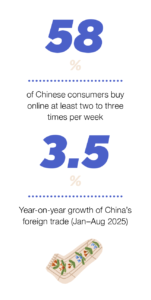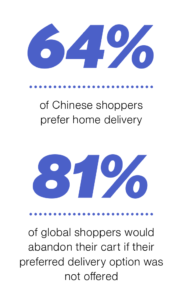
A new frontier for European businesses
The global trade landscape is undergoing a profound transformation, driven not only by traditional trade negotiations between nations, but also by the consumer behaviour of millions of online customers. At the epicentre of this digital revolution is China, where the cross-border e-commerce ecosystem has developed into a powerful force, simultaneously reflecting and accelerating shifts in trade patterns. In this article, Elaine Chen and Jane Su argue that European businesses in China must understand these shifts to navigate the future of global trade.
The rise of the Chinese cross-border e-commerce industry is a story of multiple converging forces: manufacturing strength, digital innovation and evolving consumer demand. While public attention seemed to have been focussed on geopolitical tensions, and ‘decoupling’ became a commonly used phrase, data reveals a more nuanced reality. As highlighted in The DHL Trade Atlas 2025 (Altas),[1] while the share of United States (US) imports coming directly from China has declined, the overall reliance on Chinese-made content has not substantially decreased. Goods are simply finding new routes – trade flows have continued but are now stretched out over longer distances and via diversified destinations, demonstrating a shifting geography of world trade. According to the State Council, China’s foreign trade grew 3.5 per cent year-on-year in the first eight months of 2025. Although trade with the US fell 13.5 per cent, this was offset with the Association of Southeast Asian Nations (ASEAN) showing robust growth of 9.7 per cent, and the European Union (EU) at 4.3 per cent.[2] This indicates a complex restructuring rather than a simple retreat, with Chinese manufacturing remaining deeply embedded in global value chains, and China’s still vast market size remaining indispensable for many European companies.

What matters most to global e-commerce shoppers
A major engine of this continued integration is e-commerce. A survey of 24,000 global shoppers that we conducted in 2025, [3] paints a picture of a world that is browsing and buying online more frequently than ever. Chinese consumers are among the most active globally, with 85 per cent browsing and 58 per cent buying online at least two to three times a week. This domestic digital fluency has provided the perfect testing ground for Chinese brands to hone their online strategies before going global.
Platforms like AliExpress, TEMU and Shein have become household names across Europe and the Americas, leveraging China’s manufacturing and logistics infrastructure to offer an unparalleled combination of variety, speed and affordability. Their success is built on a sophisticated understanding of digital consumer behaviour, as well as what drives online purchases, which is easy and fast delivery, flexible returns, and secure payment options. Chinese platforms have excelled at meeting these expectations, triggering even higher standards for sales and logistics service performance.
For European businesses, the implications are twofold. First, these platforms represent a formidable new competitive force. Second, and more significantly, they represent a monumental opportunity for market access. Chinese consumers are increasingly looking outward for quality, branded goods. Our 2025 survey identifies China as a top destination for cross-border shoppers globally, with 42 per cent of Chinese consumers buying from international retailers. Why do shoppers buy from other countries? Their motivations are clear: lower prices (51 per cent); products or brands not available domestically (47 per cent); wider choice (44 per cent); previous positive experiences (34 per cent); and better-quality products (33 per cent).
This presents a golden opportunity for European brands, particularly in sectors like electronics, clothing, sport, leisure and hobby items, household products, and books, which rank highly in online import categories. However, building a sense of trust across the entire value chain remains challenging. The same report notes that fear of fraud (52 per cent), longer delivery times (46 per cent), customs charges (43 per cent), return costs (33 per cent), and complex return processes (32 per cent) are the primary reasons shoppers hesitate to buy cross-border goods. Trust is the ultimate currency.
Four dimensions for a resilient e-commerce supply chain
This is where strategic supply chain diversification becomes imperative for European companies looking to win in the Chinese e-commerce space. Four dimensions would be suggested as proactive strategies: multi-shoring, multi-sourcing, adding modes of transport, and diversifying logistics operations.[4] These would build an intelligent and resilient supply chain that leverages China’s strengths while mitigating its risks.
For example, a European luxury brand might practice multi-shoring by maintaining its high-end craftsmanship in Italy or France for its flagship lines while establishing a separate, localised production or assembly facility in Asia aimed at the volume-driven e-commerce market. This brings them closer to the customer, reducing delivery times and import complexities. Many automakers are already leading this change, building gigafactories in key markets to localise production while also adopting advanced local technologies and flexible business models.
Similarly, more and more senders are diversifying modes of transport. Relying solely on one shipping mode for e-commerce deliveries to/from China is incompatible with consumer expectations on both speed and cost. A blended approach, using air freight for high-value or urgent shipments, and ocean/railway/trucking for bulkier, less time-sensitive inventory, supported by customs declaration strategies tailored for different countries, creates a resilient and cost-effective logistics flow.

The fourth dimension, diversifying logistics operations, which involves building a localised logistics footprint, is perhaps the most critical for cross-border success. A remarkable 81 per cent of global shoppers would abandon their cart if their preferred delivery option was not offered. Global online shoppers have distinct preferences for last-mile delivery – for Chinese shoppers the preferences are home delivery (38 per cent, a rate much lower than the global average of 64 per cent), parcel shops (26 per cent), and parcel lockers (24 per cent, a rate double the global average of 12 per cent). This requires a logistics provider with an extensive domestic network to allow European brands to offer a seamless, localised delivery and returns experience, which is a key driver of purchase decisions.
Trends worth monitoring
Looking ahead, several trends are expected to impact the development of China’s cross-border e-commerce.
Sustainability is a rising concern for many Chinese consumers. While price and quality remain paramount, 83 per cent of Chinese shoppers say sustainability is important to them when making an online purchase – a figure significantly higher than in many European markets. European companies have a strong story to tell here, but it must be communicated in a manner that is both respectful and connects with local audiences. Also, the number of sustainability-conscious consumers and how much they are willing to pay for sustainable products and delivery options remains a key question that businesses need to investigate further.
In addition, the integration of artificial intelligence (AI) will redefine the shopping experience, encompassing both positive and negative aspects. Chinese consumers are among the most open to AI-powered features, with 77 per cent interested in virtually trying on products and 76 per cent interested in AI-powered shopping assistants. European brands must invest in these technologies to remain competitive in a market that is at the forefront of digital innovation. Potential negative impacts associated with AI must be proactively mitigated, such as data privacy and security risks, algorithmic bias and discrimination, and accountability issues.
Given the deep integration of social commerce into Chinese consumer behaviour—evidenced by the fact that 96 per cent of Chinese shoppers have made purchases through social platforms, with 92 per cent expecting it to become their primary shopping channel by 2030—European companies must urgently adapt their digital engagement strategies. It is recommended that businesses actively establish and maintain a visible, interactive presence on key Chinese social media platforms. Furthermore, 89 per cent of consumers are influenced by trending or viral products, highlighting the importance of leveraging data analytics and localised influencer partnerships to identify and capitalise on emerging trends quickly. Since 90 per cent of shoppers express interest in live-streamed shopping events, investing in high-quality, interactive live e-commerce capabilities should be a priority to enhance product demonstration and consumer trust. Finally, with 68 per cent of buyers’ decisions being affected by social media reviews, proactively managing digital reputation, encouraging user-generated content, and highlighting positive customer feedback are essential to building credibility and driving conversion.
Globally, the rapid expansion of Chinese e-commerce platforms is having a significant distortive impact on third markets, triggering a major regulatory backlash. The high volume of small, low-value direct shipping parcels benefits from the de minimis policy, which allows goods under a certain value to be imported with little to no duty or scrutiny. Arguing that this creates an unlevel playing field for domestic retailers, and leads to tax evasion, the US has already revoked the de minimis privilege for shipments from China, with the European Union widely expected to follow suit. It still remains to be seen how regulatory changes in the two largest destination markets will shape the evolution of China’s cross-border e-commerce industry.
Conclusion
Successful e-commerce depends on building a resilient, customer-centric, and digitalised global trade network. Chinese cross-border e-commerce is not a disruptor to be feared, but can be a powerful new channel to be utilised. For European businesses, the path forward requires a dual strategy: defend domestic markets by learning from the agility of Chinese e-commerce platforms, and deep diving into the Chinese market by building trusted relationships with Chinese consumers. By doing so, European companies can leverage the immense power of China’s digital trade revolution, ensuring they are not merely observers of the new global trade landscape, but active and successful participants in shaping it.
Elaine Chen is the national chair of the European Chamber’s Logistics Working Group, and vice president, public affairs of DHL Group China. Jane Su is public affairs manager of DHL Group China.
DHL Group is the world’s leading
logistics company, offering an unrivalled portfolio of logistics services
ranging from national and international postal service, parcel delivery,
e-commerce shipping and fulfilment solutions, international express, road, air
and ocean transport to industrial supply chain management. With sustainable
business practices and a commitment to society and the environment, the Group
makes a positive contribution to the world. DHL Group aims to achieve net-zero
emissions logistics by 2050.
[1] Altman, S.A., and Bastian, C.R., The DHL Trade Atlas 2025, NYU Stern School of Business, 12st March 2025, viewed 21st September 2025, p. 11 <https://www.dhl.com/global-en/microsites/core/global-connectedness/trade-atlas.html>
[2] China’s foreign trade sustains stable growth despite external headwinds, State Council, 8th September 2025, viewed 21st September 2025, <http://english.www.gov.cn/archive/statistics/202509/08/content_WS68be6e1dc6d0868f4e8f565c.html>
[3] DHL’s E-Commerce Trends Report 2025: AI and social media reshaping online shopping, DHL, 4th June 2025, viewed 21st September 2025, <https://www.dhl.com/content/dam/dhl/local/global/dhl-ecommerce/documents/pdf/g0-dhl-e-commerce-trends-report-2025.pdf>
[4] DHL Logistics Trend Radar 7.0, DHL, 2nd September 2024, viewed 30th September 2025, p. 64 <https://www.dhl.com/content/dam/dhl/global/csi/documents/pdf/glo-csi-logistics-trend-radar-7-0.pdf>


Recent Comments